Sensitivity of Precipitation to Aerosol and Temperature Perturbation over the Foothills of the Nepal Himalayas †
Abstract
:1. Introduction
- How will the precipitation respond to aerosol and temperature perturbations?
- How is the spatial distribution of the precipitation affected by aerosol perturbations?
- How are these perturbations manifested in the microphysical properties of the clouds?
2. Numerical Model
3. Cloud Microphysical Description
4. Model Setup
5. Results
5.1. Activation of CCN and IN
5.1.1. Case Study I
5.1.2. Case Study II
5.1.3. Case Study III
5.2. Distribution of Clouds and Rain
5.2.1. Case Study I
5.2.2. Case Study II
5.2.3. Case Study III
5.3. Precipitation Sensitivity to Aerosol and Temperature Perturbations
5.3.1. Case Study I
5.3.2. Case Study II
5.3.3. Case Study III
6. Discussion and Conclusions
Author Contributions
Acknowledgments
Conflicts of Interest
References
- Mooley, D.A.; Parthasarathy, B. Fluctuations in All-India summer monsoon rainfall during 1871–1978. Clim. Chang. 1984, 6, 287–301. [Google Scholar] [CrossRef]
- Turner, A.G.; Annamalai, H. Climate change and the South Asian summer monsoon. Nat. Clim. Chang. 2012, 2, 587–595. [Google Scholar] [CrossRef]
- Duncan, J.M.A.; Biggs, E.M.; Dash, J.; Atkinson, P.M. Spatio-temporal trends in precipitation and their implication for water resources management in climate-sensitive Nepal. Appl. Geogr. 2013, 43, 138–146. [Google Scholar] [CrossRef]
- Webster, P.J.; Magana, V.O.; Palmer, T.N.; Shukla, J.; Tomas, R.A.; Yanai, M.U.; Yasunari, T. Monsoons: Processes, predictability, and the prospects for prediction. J. Geophys. Res. 1998, 103, 14451–14510. [Google Scholar] [CrossRef]
- Li, J.; Wang, B.; Yang, Y.-M. Retrospective seasonal prediction of summer monsoon rainfall over West Central and Peninsular India in the past 142 years. Clim Dyn. 2016, 48, 2581–2596. [Google Scholar] [CrossRef]
- Kumar, K.K.; Kumar, K.R.; Ashrit, R.G.; Deshpande, N.R.; Hansen, J.W. Climate Impacts on Indian agriculture. Int. J. Climatol. 2004, 24, 1375–1393. [Google Scholar] [CrossRef]
- Reuter, M.; Kern, A.K.; Harzhauser, M.; Kroh, A.; Piller, W.E. Global warming and South Indian monsoon rainfall - lessons from the Mid-Miocene. Gondwana Res. 2013, 23, 1172–1177. [Google Scholar] [CrossRef]
- Das, L.; Meher, J.K.; Dutta, M. Construction of rainfall change scenarios over teh Chilka Lagoon in India. Atmos. Res. 2016, 182, 36–45. [Google Scholar] [CrossRef]
- IPCC. Climate Change 2014: Synthesis Report. Contribution of Working Groups I, II and III to the Fifth Assessment Report of the Intergovernmental Panel on Climate Change; IPCC: Geneva, Switzerland, 2014; 151p. [Google Scholar]
- Liu, X.; Chen, B. Climatic warming in the Tibetan Plateau during recent decades. Int. J. Climatol. 2000, 20, 1729–1742. [Google Scholar] [CrossRef]
- Shrestha, A.B.; Wake, C.P.; Mayewski, P.A.; Dibb, J.E. Maximum Temperature Trends in the Himalaya and Its Vicinity: An Analysis Based on Temperature Records from Nepal for the Period 1971–94. J. Clim. 1999, 12, 2775–2786. [Google Scholar] [CrossRef]
- Ghatak, D.; Sinsky, E.; Miller, J. Role of snow-albedo feedback in higher elevation warming over the Himalayas, Tibetan Plateau and Central Asia. Environ. Res. Lett. 2014, 9, 114008. [Google Scholar] [CrossRef]
- Soden, B.J.; Jackson, D.L.; Ramaswamy, V.; Schwarzkopf, M.D.; Huang, X. The Radiative Signature of Upper Tropospheric Moistening. Science 2005, 310, 841–844. [Google Scholar] [CrossRef] [PubMed]
- Gautam, R.; Hsu, N.C.; Lau, K.-M.; Kafatos, M. Aerosol and rainfall variability over the Indian monsoon region: Distributions, trends and coupling. Ann. Geophys. 2009, 27, 3691–3703. [Google Scholar] [CrossRef]
- Wang, C.; Kim, D.; Ekman, A.M.L.; Barth, M.C.; Rasch, P.J. Impact of anthropogenic aerosols on Indian summer monsoon. Geophys. Res. Lett. 2009, 36, L21704. [Google Scholar] [CrossRef]
- Twomey, S. The influence of pollution on the shortwave albedo of clouds. J. Atmos. Sci. 1977, 34, 1149–1152. [Google Scholar] [CrossRef]
- Albrecht, B.A. Aerosols, Cloud Microphysics, and Fractional Cloudiness. Science 1989, 245, 1227–1230. [Google Scholar] [CrossRef]
- Demott, P.J.; Chen, Y.; Kreidenweis, S.M.; Rogers, D.C.; Sherman, D.E. Ice formation by black carbon particles. Geophys. Res. Lett. 1999, 26, 2429–2432. [Google Scholar] [CrossRef]
- DeMott, P.J.; Prenni, A.J.; Liu, X.; Kreidenweis, S.M.; Petters, M.D.; Twohy, C.H.; Richardson, M.S.; Eidhammer, T.; Rogers, D.C. Predicting global atmospheric ice nuclei distributions and their impacts on climate. Proc. Natl. Acad. Sci. USA 2010, 107, 11217–11222. [Google Scholar] [CrossRef]
- Lohmann, U.; Feichter, J. Global indirect aerosol effects: A review. Atmos. Chem. Phys. 2005, 5, 715–737. [Google Scholar] [CrossRef]
- Wang, B. The Asian Monsoon; Praxis Publishing Ltd.: Chichester, UK, 2006. [Google Scholar]
- Houze, R.A.; Wilton, D.C.; Smull, B.F. Monsoon convection in the Himalayan region as seen by the TRMM Precipitation Radar. Q. J. R. Meteorol. Soc. 2007, 133, 1389–1411. [Google Scholar] [CrossRef]
- Shrestha, P.; Barros, A.P.; Khlystov, A. Chemical composition and aerosol size distribution of the middle mountain range in the Nepal Himalayas during the 2009 pre-monsoon season. Atmos. Chem. Phys. 2010, 10, 11605–11621. [Google Scholar] [CrossRef]
- Lynn, B.; Khain, A.; Rosenfeld, D.; Woodely, W.L. Effect of aerosols on precipitation from orographic clouds. J. Geophys. Res. 2007, 112, D10225. [Google Scholar] [CrossRef]
- Jirak, I.L.; Cotton, W.R. Effects of air pollution on precipitation along the front range of the Rocky Mountains. J. Appl. Meteorol. Climatol. 2006, 45, 236–245. [Google Scholar] [CrossRef]
- Muhlbauer, A.; Lohmann, U. Sensitivity Studies of the Role of Aerosols in Warm-Phase Orographic Precipitation in Different Dynamical Flow Regimes. J. Atmos. Sci. 2008, 65, 2522–2541. [Google Scholar] [CrossRef]
- Collins, M.R.; Knutti, J.A.; Dufresne, J.-L.; Fichefet, T.; Friedlingstein, P.; Gao, X.; Gutowski, W.J.; Johns, T.; Krinner, G.; Shongwe, M.; et al. Long-term Climate Change: Projections, Commitments and Irreversibility. In Climate Change 2013: The Physical Science Basis. Contribution of Working Group I to the Fifth Assessment Report of the Intergovernmental Panel on Climate Change; Cambridge University Press: Cambridge, UK; New York, NY, USA, 2013. [Google Scholar]
- Lee, S.-S.; Feingold, G. Precipitating cloud-system response to aerosol perturbations. Geophys. Res. Lett. 2010, 37, L23806. [Google Scholar] [CrossRef]
- Klemp, J.B.; Dudhia, J.; Hassiotis, A. An Upper Gravity Wave Absorbing Layer for NWP Applications. Mon. Weather Rev. 2008, 136, 3987–4004. [Google Scholar] [CrossRef]
- Skamarock, W.C.; Klemp, J.B.; Dudhia, J.; Grill, D.O.; Barker, D.M.; Duda, M.G.; Huang, X.Y.; Wang, W.; Powers, J.G. A Description of the Advanced Research WRF Version 3; Technical Report; National Center for Atmospheric Research: Boulder, CO, USA, 2008; 113p. [Google Scholar]
- Shrestha, R.K.; Connolly, P.J.; Gallagher, M.W. Sensitivity of WRF cloud microphysics to simulations of a convective storm over the Nepal Himalayas. Open Atmos. Sci. J. 2016, submitted. [CrossRef]
- Jimenez, P.A.; Gonzalez-Rouco, J.F.; Gracia-Bustamante, E.; Navarro, J.; Nontavez, J.P.; De Arellano, J.V.G.; Dudhia, J.; Muñoz-Roldan, A. SurfaceWind Regionalization over Complex Terrain: Evaluation and Analysis of a High-Resolution WRF Simulation. J. Appl. Meteorol. Clim. 2010, 49, 268–287. [Google Scholar] [CrossRef]
- Ikeda, K.; Rasmussen, R.; Liu, C.; Gochis, D.; Yates, D.; Chen, F.; Tewari, M.; Barlage, M.; Dudhia, J.; Miller, K.; et al. Simulation of seasonal snowfall over Colorado. Atmos. Res. 2010, 97, 462–477. [Google Scholar] [CrossRef]
- Rasmussen, R.; Liu, C.; Ikeda, K.; Gochis, D.; Yates, D.; Chen, F.; Tewari, M.; Barlage, M.; Dudhia, J.; Yu, W.; et al. High-resolution coupled climate runoff simulations of seasonal snowfall over Colorado: A process study of current and warmer climate. J. Clim. 2011, 24, 3015–3048. [Google Scholar] [CrossRef]
- Liu, C.; Ikeda, K.; Rasmussen, R.; Barlage, M.; Newman, A.J.; Prein, A.F.; Chen, F.; Chen, L.; Clark, M.; Dai, A.; et al. Continental-scale convection-permitting modeling of the current and future climate of North America. Clim. Dyn. 2016, 49, 71–95. [Google Scholar] [CrossRef]
- Maussion, F.; Scherer, D.; Finkelnburg, R.; Richters, J.; Yang, W.; Yao, T. WRF simulation of a precipitation event over the Tibetan Plateau, China—And assessment using remote sensing and ground observations. Hydrol. Earth Syst. Sci. Dissuss. 2010, 7, 3551–3589. [Google Scholar] [CrossRef]
- Morrison, H.; Curry, J.A.; Khvorostyanov, V.I. A New Double-Moment Microphysics Parameterization for Application in Cloud and ClimateModels. Part I: Description. J. Atmos. Sci. 2005, 62, 1665–1676. [Google Scholar] [CrossRef]
- Morrison, H.; Thompson, G.; Tatarskii, V. Impact of Cloud Microphysics on the Development of Trailing Stratiform Precipitation in a Simulated Squall Line: Comparison of One- and Two-Moment Schemes. Mon. Weather Rev. 2009, 137, 991–1007. [Google Scholar] [CrossRef]
- Twomey, S. The nuclei of natural cloud formation part II: The supersaturation in natural clouds and the variation of cloud droplet concentration. Geofisica Pura Appl. 1959, 43, 243–249. [Google Scholar] [CrossRef]
- Rogers, R.R.; Yau, M.K. A short Course in Cloud Physics, 3rd ed.; Pergamon Press: Oxford, UK; New York, NY, USA, 1989. [Google Scholar]
- Khairoutdinov, M.; Kogan, Y. A new Cloud Physics Parameterization in a Large-Eddy Simulation Model of Marine Stratocumulus. Mon. Weather Rev. 2000, 128, 229–243. [Google Scholar] [CrossRef]
- Rasmussen, R.M.; Geresdi, I.; Thompson, G.; Manning, K.; Karplus, E. The Role of Radiative Cooling of Clouds Droplets, Cloud Condensation Nuclei, and Ice Initiation. J. Atmos. Sci. 2002, 59, 837–860. [Google Scholar] [CrossRef]
- Hallett, J.; Mossop, S.C. Production of secondary ice particles during the riming process. Nature 1974, 249, 26–28. [Google Scholar] [CrossRef]
- Dudhia, J. Numerical study of convection observed during the winter monsoon experiment using a mesoscale two-dimensional model. J. Atmos. Sci. 1989, 46, 3077–3107. [Google Scholar] [CrossRef]
- Mlawer, E.J.; Taubman, S.J.; Brown, P.D.; Iacono, M.J.; Clough, S.A. Radiative transfer for inhomogeneous atmosphere: RRTM, a validated correlated-k model for the longwave. J. Geophys. Res. 1997, 102, 16663–16682. [Google Scholar] [CrossRef]
- Hong, S.Y.; Noh, Y.; Dudhia, J. A new vertical diffusion package with an explicit treatment of entrainment processes. Mon. Weather Rev. 2006, 143, 2318–2341. [Google Scholar] [CrossRef]
- Connolly, P.J.; Vaughan, G.; May, P.T.; Chemel, C.; Allen, G.; Choularton, T.W.; Gallagher, M.W.; Bower, K.N.; Crosier, J.; Dearden, C. Can aerosol influence deep tropical convection? Aerosol indirect effects in the Hector island thunderstorm. Q. J. R. Meteorol. Soc. 2013, 139, 2190–2208. [Google Scholar] [CrossRef]
- Konwar, M.; Maheskumar, R.S.; Kulkarni, J.R.; Freud, E.; Goswami, B.N.; Rosenfeld, D. Aerosol control on depth of warm rain in convective clouds. J. Geophys. Res. 2012, 117, D13204. [Google Scholar] [CrossRef]
- Pruppacher, H.R.; Klett, J.D. Microphysics of Clouds and Precipitation; Atmospheric and Oceanographic Sciences Library, Kluwer Academic Publishers: Dordrecht, The Netherlands, 1997. [Google Scholar]
- Muhlbauer, A.; Hashino, T.; Xue, L.; Teller, A.; Lohmann, U.; Rasmussen, R.M.; Geresdi, I.; Pan, Z. Intercomparison of aerosol-cloud-precipitation interaction in stratiform orographic mixed-phase clouds. Atmos. Chem. Phys. 2010, 10, 8173–8196. [Google Scholar] [CrossRef]
- Connolly, P.J.; Choularton, T.W.; Gallagher, W.W.; Bower, K.N.; Flynn, M.J.; Whiteway, J.A. Cloud-resolving simulations of intense tropical Hector thunderstorms:Implications for aerosol cloud interactions. Q. J. R. Meteorol. Soc. 2006, 132, 3079–3106. [Google Scholar] [CrossRef]
- Chen, J.-P.; Lamb, D. Simulation of cloud microphysical and chemical processes using a multicomponent framework. Part II: Microphysical evolution of a wintertime orographic cloud. J. Atmos. Sci. 1999, 56, 2293–2312. [Google Scholar] [CrossRef]
- Barros, A.P.; Lettenmaier, D.P. Dynamic Modeling of Orographically Induced Precipitation. Rev. Geophys. 1994, 32, 265–284. [Google Scholar] [CrossRef]
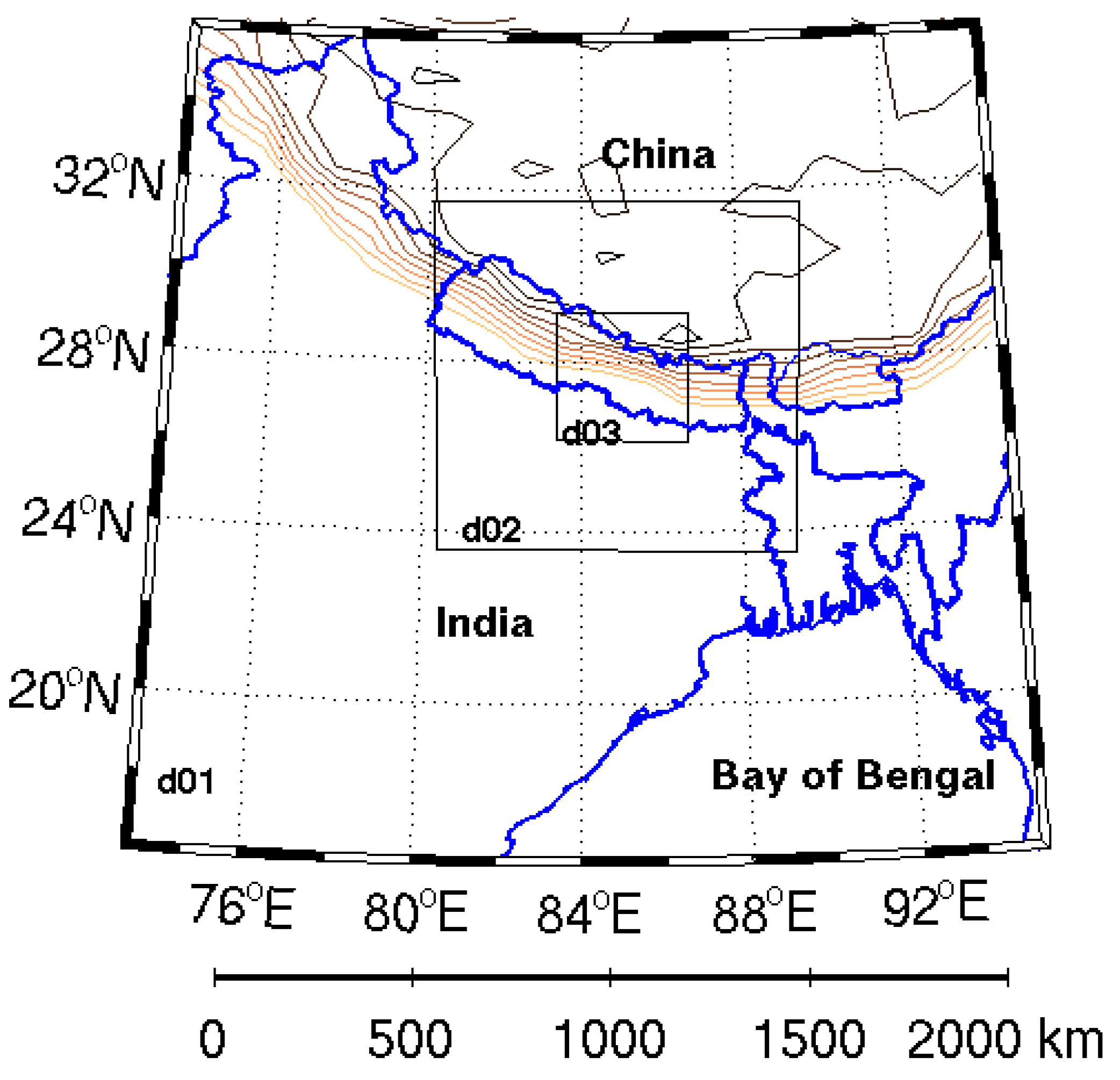
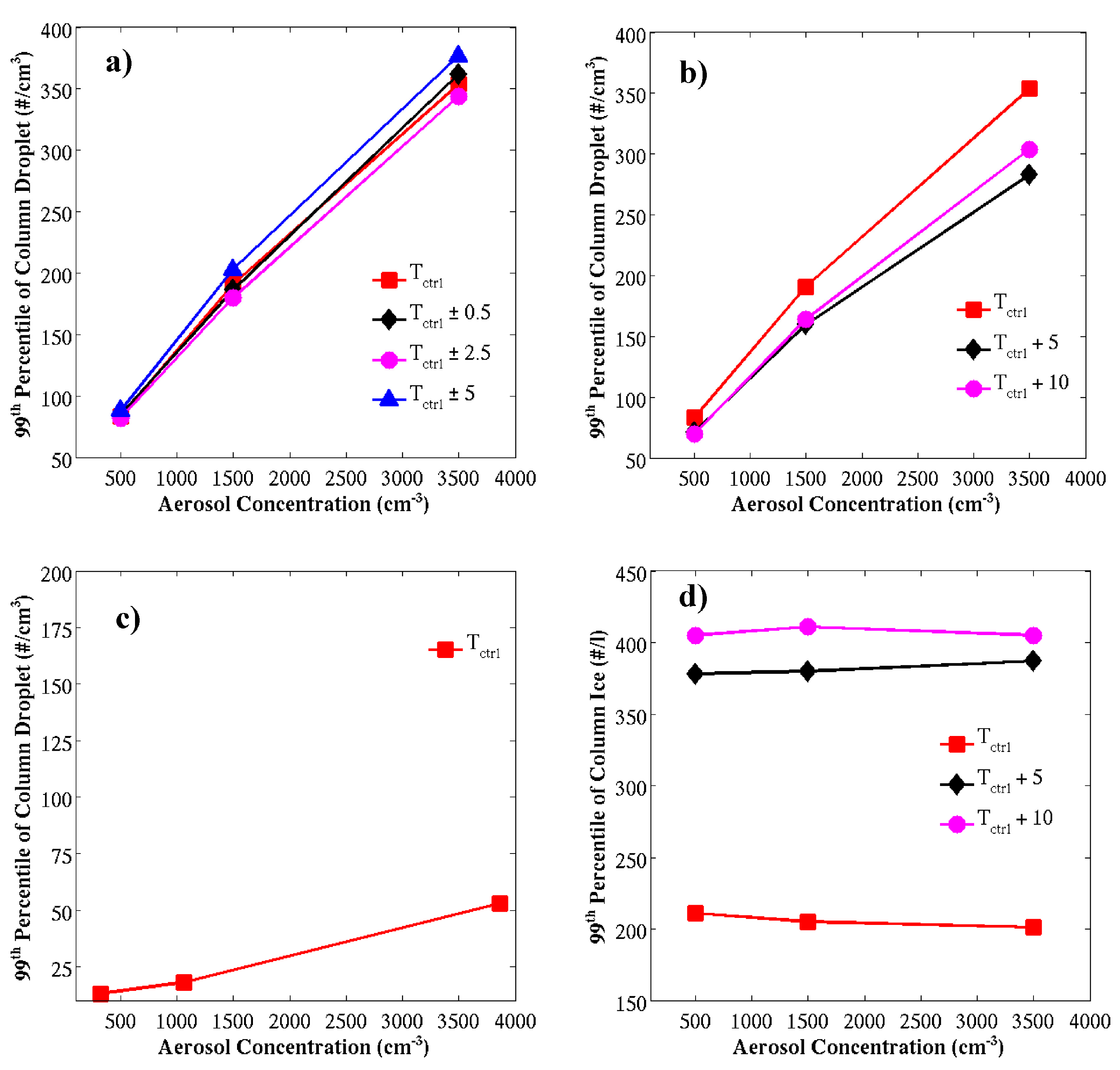
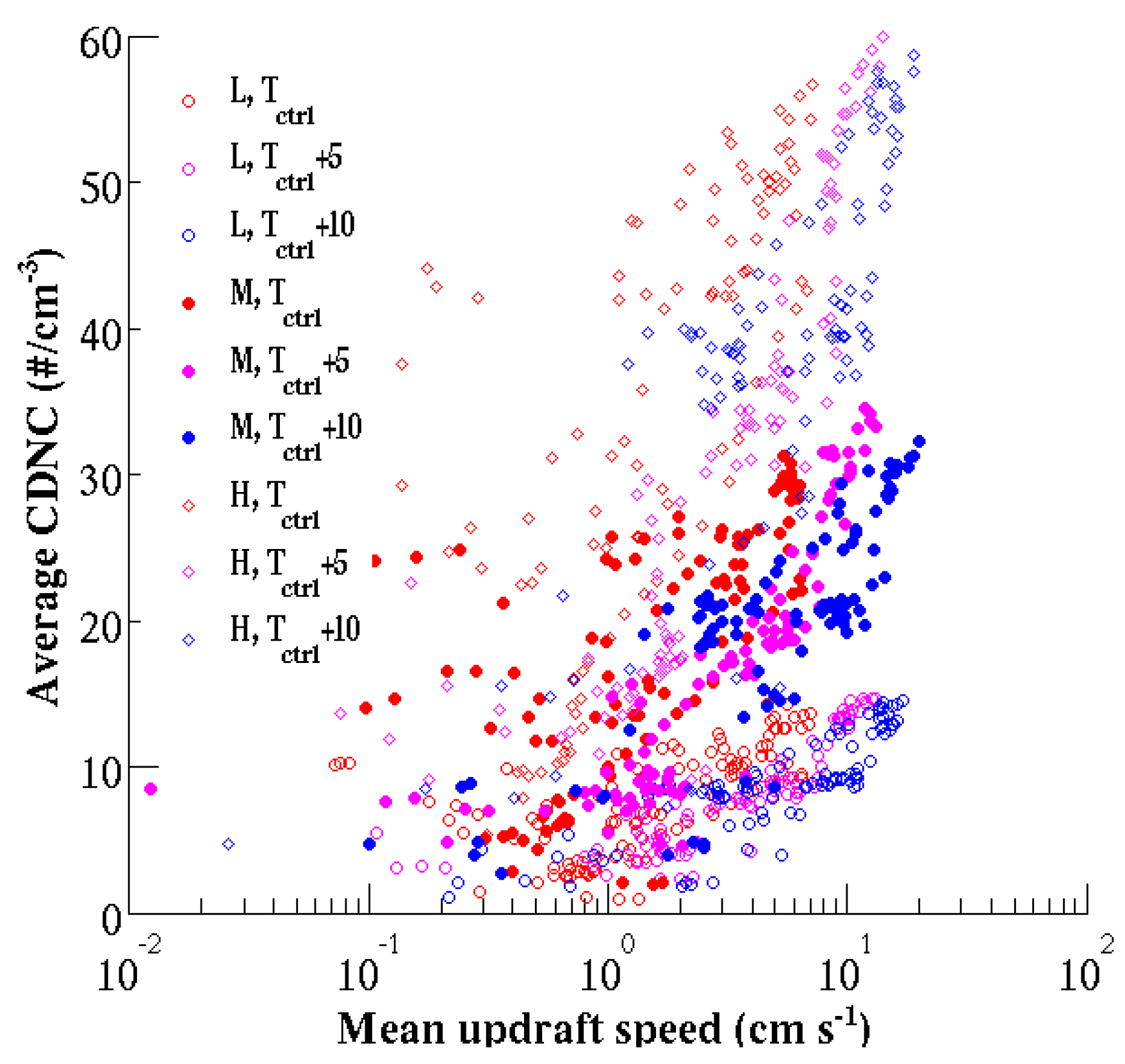
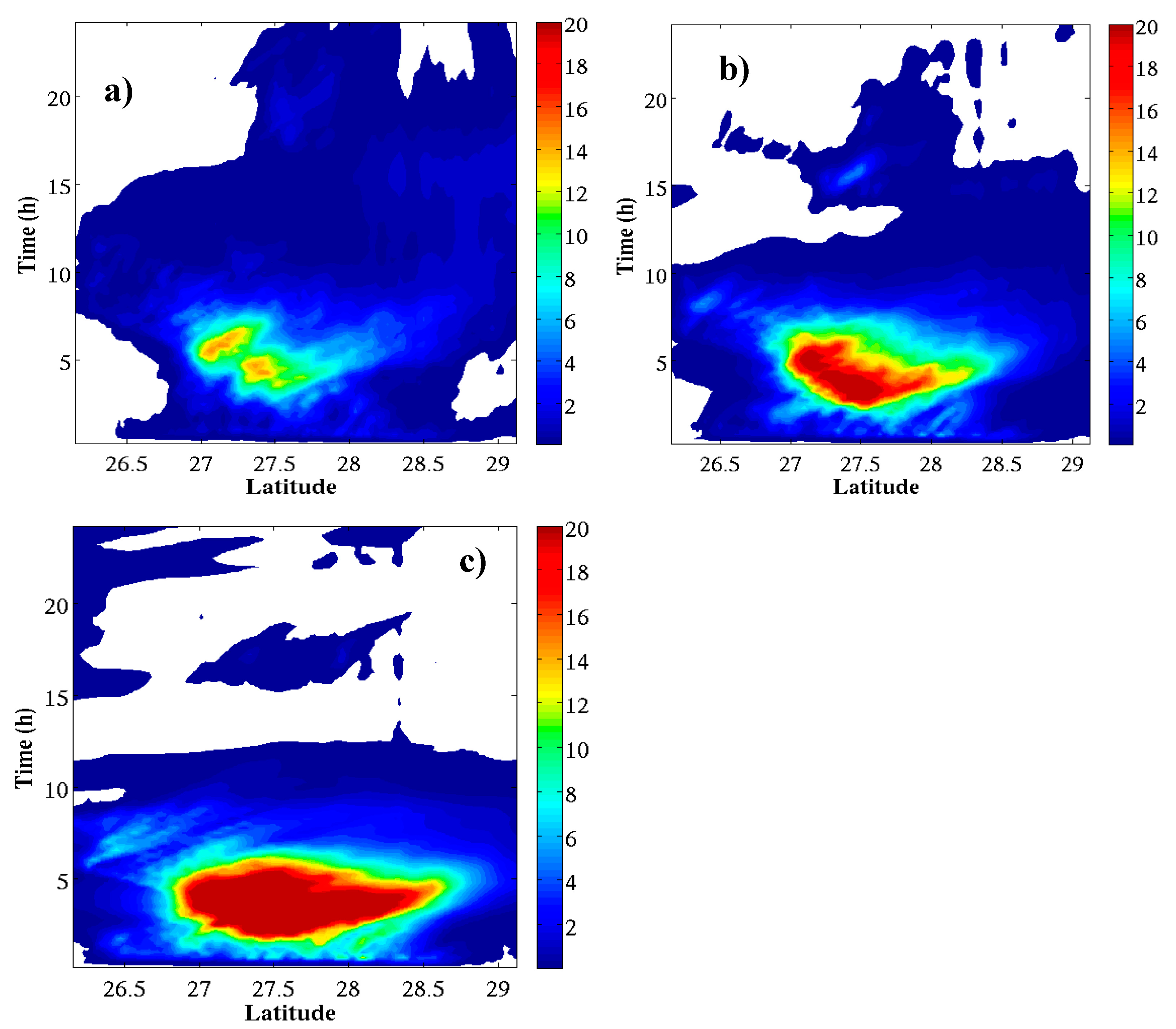
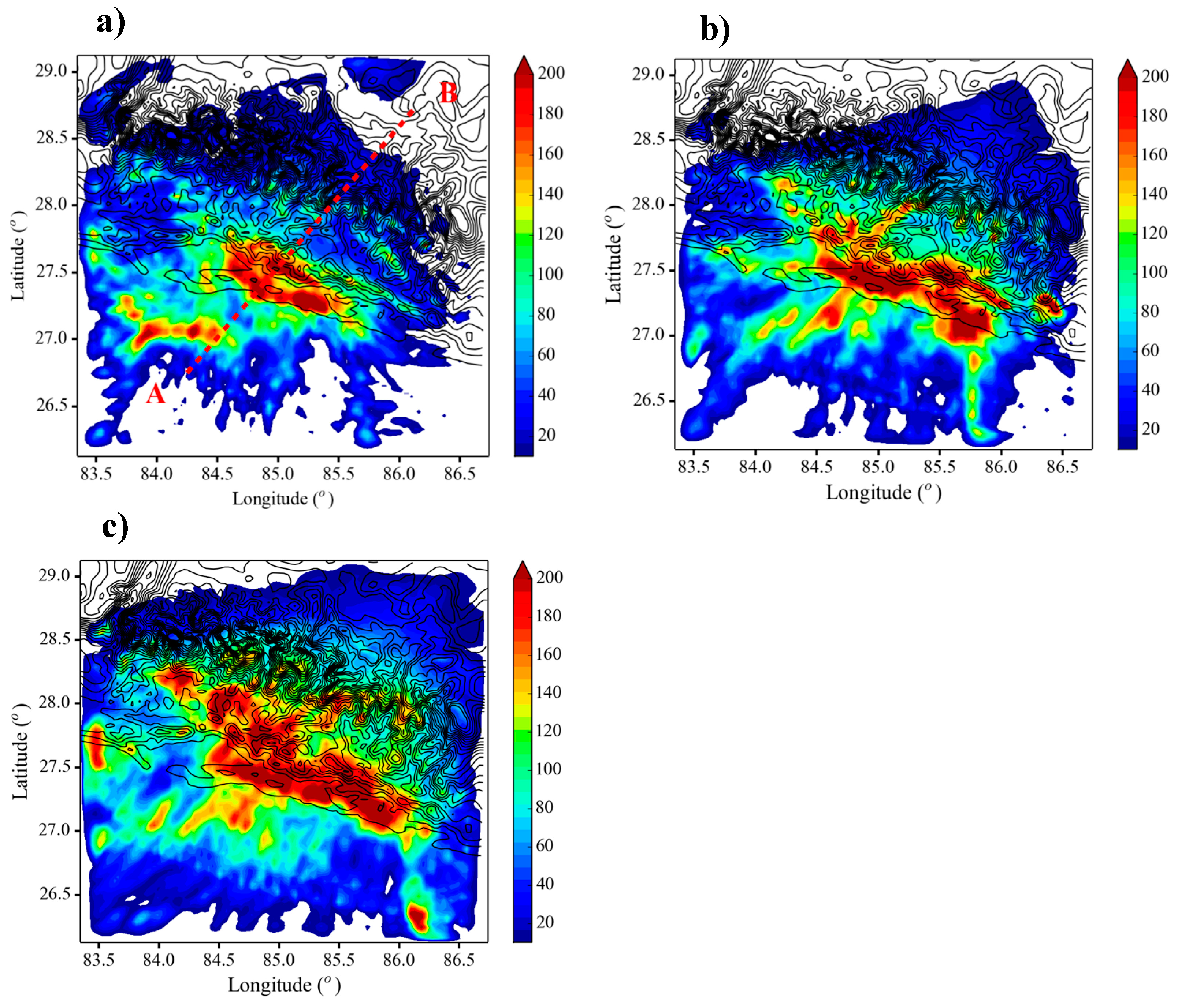

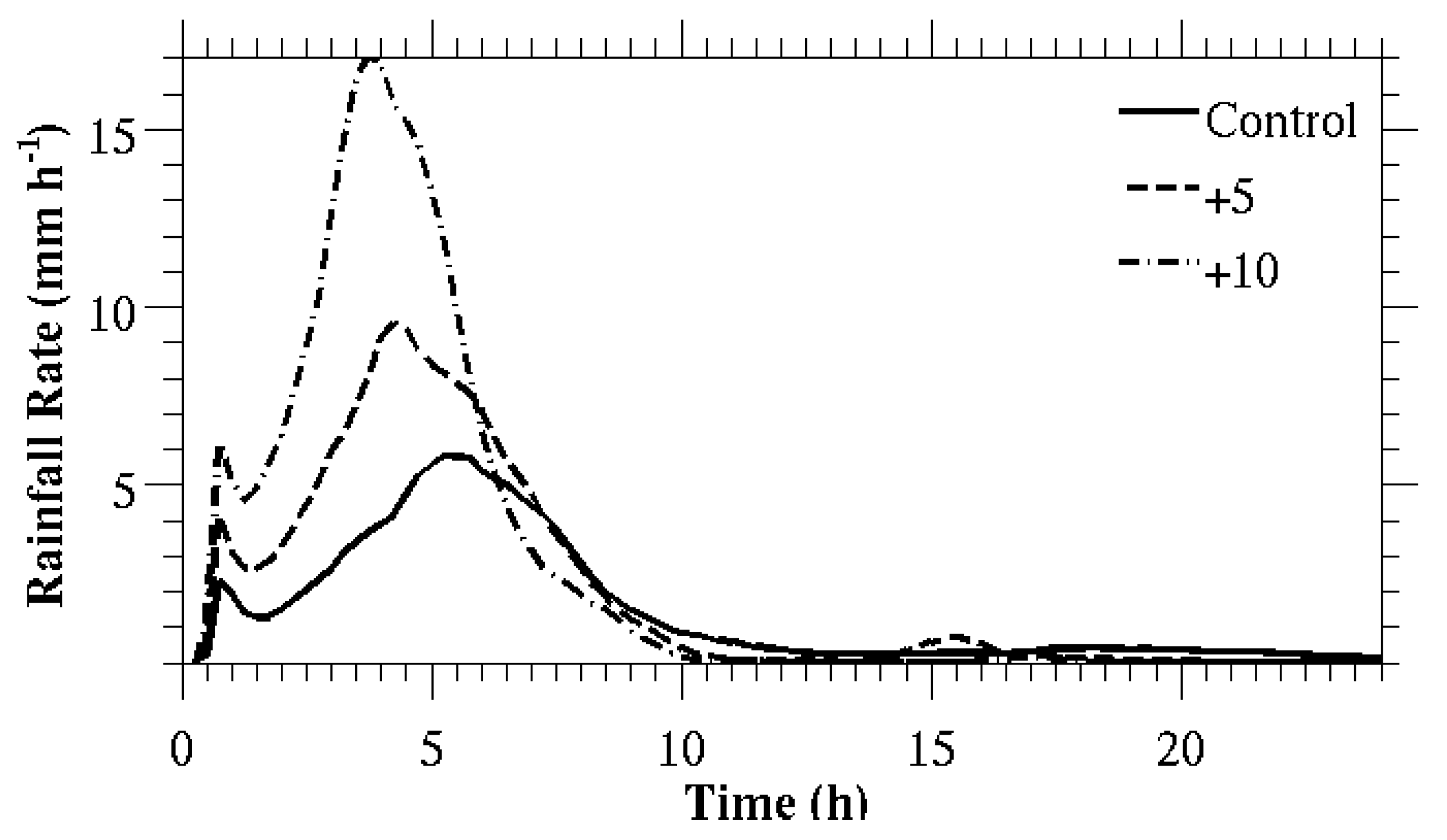
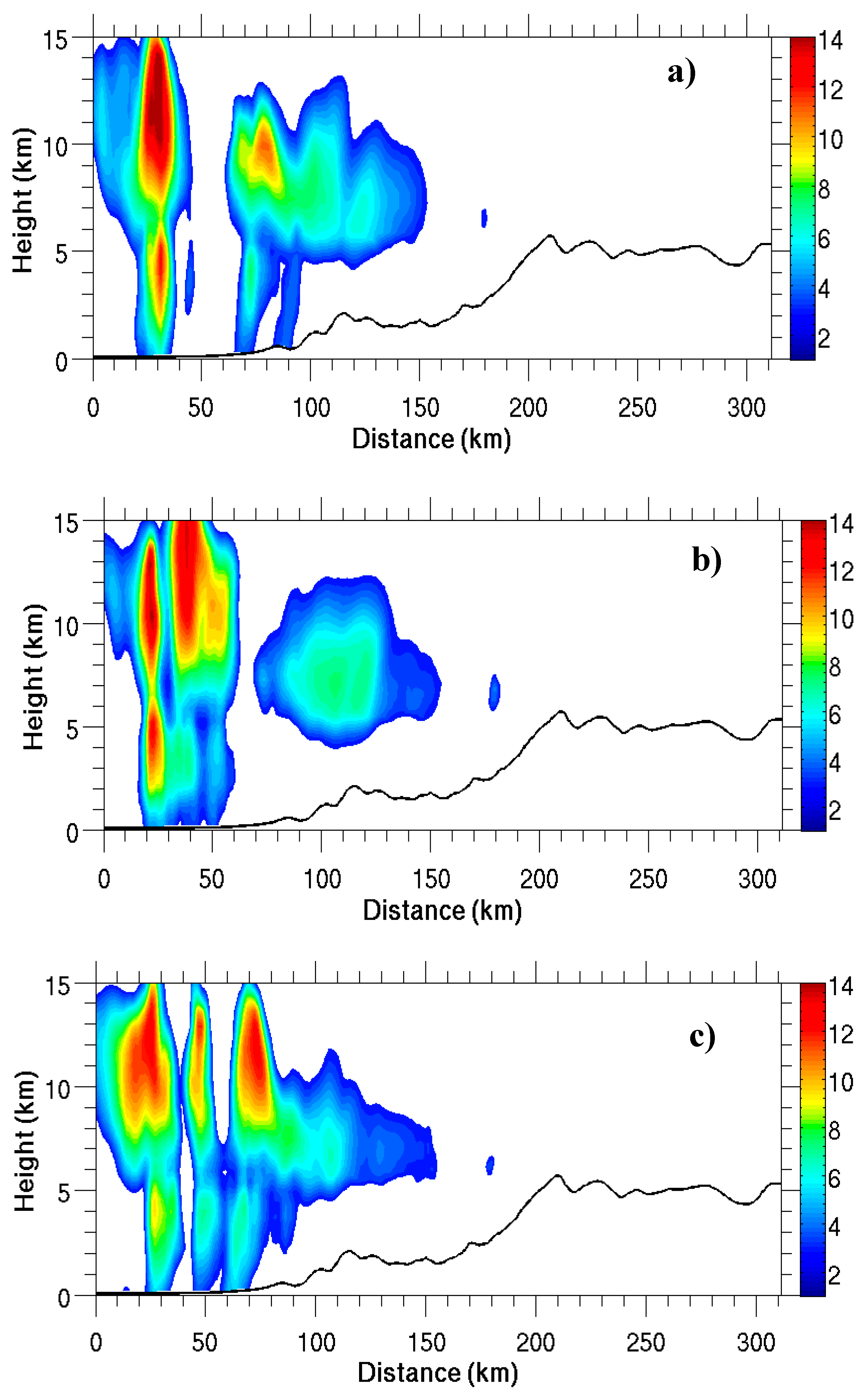
| Simulation | Case-I | Case-II | Case-III | ||||||
|---|---|---|---|---|---|---|---|---|---|
| Low | Medium | High | Low | Medium | High | Low | Medium | High | |
| Control (Tctrl) | 14.85 | 14.80 | 14.77 | 14.84 | 14.82 | 14.78 | 15.21 | 15.21 | 15.21 |
| Uniform temperature perturbation | |||||||||
| Tctrl + 5 | 14.95 | 14.91 | 14.90 | - | - | - | - | - | - |
| Tctrl + 10 | 14.93 | 14.89 | 14.86 | - | - | - | - | - | - |
| Random temperature perturbation | |||||||||
| Tctrl ± 0.5 | 14.84 | 14.81 | 14.76 | 14.85 | 14.82 | 14.79 | 15.21 | 15.21 | 15.21 |
| Tctrl ± 2.5 | 14.85 | 14.82 | 14.78 | 14.85 | 14.82 | 14.80 | 15.21 | 15.21 | 15.21 |
| Tctrl ± 5 | 14.81 | 14.75 | 14.72 | 14.82 | 14.78 | 14.77 | 15.21 | 15.21 | 15.21 |
| Prognostic CCN | 14.58 | 14.64 | 14.58 | - | - | - | - | - | - |
| Simulation | Case-I | Case-II | Case-III | ||||||
|---|---|---|---|---|---|---|---|---|---|
| Low | Medium | High | Low | Medium | High | Low | Medium | High | |
| Control (Tctrl) | 38.45 | 38.66 | 38.74 | 31.20 | 31.14 | 31.26 | 26.43 | 26.43 | 26.44 |
| Uniform temperature perturbation | |||||||||
| Tctrl + 5 | 35.48 | 35.60 | 35.26 | - | - | - | - | - | - |
| Tctrl + 10 | 37.12 | 37.36 | 36.89 | - | - | - | - | - | - |
| Random temperature perturbation | |||||||||
| Tctrl ± 0.5 | 38.97 | 38.89 | 38.83 | 31.51 | 31.45 | 31.34 | 26.44 | 26.44 | 26.44 |
| Tctrl ± 2.5 | 39.00 | 39.16 | 39.16 | 31.82 | 31.81 | 31.77 | 26.54 | 26.54 | 26.54 |
| Tctrl ± 5 | 39.05 | 39.19 | 39.26 | 32.56 | 32.50 | 32.45 | 26.57 | 26.57 | 26.58 |
| Prognostic CCN | 29.87 | 29.36 | 29.22 | - | - | - | - | - | - |
| Simulation | Case-I | Case-II | Case-III | ||||||
|---|---|---|---|---|---|---|---|---|---|
| Low | Medium | High | Low | Medium | High | Low | Medium | High | |
| Control (Tctrl) | 34.5 | 35.0 | 35.2 | 51.8 | 51.0 | 50.9 | 0.3 | 0.3 | 0.3 |
| Uniform temperature perturbation | |||||||||
| Tctrl + 5 | 47.1 | 47.1 | 46.2 | - | - | - | - | - | - |
| Tctrl + 10 | 66.7 | 66.6 | 67.7 | - | - | - | - | - | - |
| Random temperature perturbation | |||||||||
| Tctrl ± 0.5 | 36.3 | 35.6 | 36.1 | 53.1 | 52.1 | 52.3 | 0.3 | 0.3 | 0.3 |
| Tctrl ± 2.5 | 32.4 | 32.4 | 31.8 | 47.9 | 48.1 | 48.0 | 0.3 | 0.3 | 0.3 |
| Tctrl ± 5 | 29.6 | 29.0 | 30.2 | 46.0 | 45.9 | 45.4 | 0.4 | 0.4 | 0.4 |
| Prognostic CCN | 21.1 | 20.6 | 20.7 | - | - | - | - | - | - |
Publisher’s Note: MDPI stays neutral with regard to jurisdictional claims in published maps and institutional affiliations. |
© 2017 by the authors. Licensee MDPI, Basel, Switzerland. This article is an open access article distributed under the terms and conditions of the Creative Commons Attribution (CC BY) license (https://creativecommons.org/licenses/by/4.0/).
Share and Cite
Shrestha, R.K.; Connolly, P.J.; Gallagher, M.W. Sensitivity of Precipitation to Aerosol and Temperature Perturbation over the Foothills of the Nepal Himalayas. Proceedings 2017, 1, 144. https://doi.org/10.3390/ecas2017-04146
Shrestha RK, Connolly PJ, Gallagher MW. Sensitivity of Precipitation to Aerosol and Temperature Perturbation over the Foothills of the Nepal Himalayas. Proceedings. 2017; 1(5):144. https://doi.org/10.3390/ecas2017-04146
Chicago/Turabian StyleShrestha, Rudra K., Paul J. Connolly, and Martin W. Gallagher. 2017. "Sensitivity of Precipitation to Aerosol and Temperature Perturbation over the Foothills of the Nepal Himalayas" Proceedings 1, no. 5: 144. https://doi.org/10.3390/ecas2017-04146
APA StyleShrestha, R. K., Connolly, P. J., & Gallagher, M. W. (2017). Sensitivity of Precipitation to Aerosol and Temperature Perturbation over the Foothills of the Nepal Himalayas. Proceedings, 1(5), 144. https://doi.org/10.3390/ecas2017-04146






